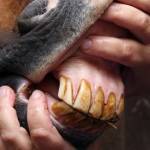Dental Disease in Horses

Unlike permanent human teeth that remain relatively unchanged in size or shape during an adult’s lifetime, a horse’s teeth continue to erupt so that as the biting surfaces are slowly worn away, the teeth advance from the gums at approximately the same rate. The shape of each equine tooth also changes somewhat as the horse ages, and this process, coupled with the angle at which the teeth protrude from the gums, can be used as a rough gauge to determine how old the horse is.
Owners of horses with dental problems may notice that the horse doesn’t chew as well, drops wads of balled-up forage, loses weight, or throws his head when bit pressure is applied.Because of the horse’s circular chewing action and the fact that the upper molars are offset from those in the lower jaw, sharp points often form on the teeth. At a yearly or twice-yearly visit, a veterinarian can smooth these points, allowing the horse to chew its grain and forage in comfort. For many horses, this routine care keeps their teeth in good condition. However, some horses have dental trouble such as loose teeth, irritated or bleeding gums, food getting stuck between the teeth, and foul-smelling breath. Some teeth may also become misaligned, tipping toward either the cheek or the tongue. If a tipped tooth doesn’t meet its corresponding tooth in the opposite jaw, that tooth may also become misaligned.
Owners of horses with dental problems may notice that the horse doesn’t chew as well, drops wads of balled-up forage (quidding),loses weight, or throws his head when bit pressure is applied. Causes and treatment of these problems may be different depending on a horse’s age. In young horses, smoothing the chewing surfaces is the first step, but more involved care may be needed. For horses that get feed or forage packed between adjoining teeth, the material can be picked or washed out, and irritation or infection of soft tissue can be treated. To keep the problem from recurring, the veterinarian can widen the space by carefully burring off a bit of one or both of the teeth adjoining the place where feed collects. Alternately, he can fill the interdental space to keep material from packing into it.
Loosened teeth are not uncommon in old horses where a tooth has very little root left in the jaw. If the tooth is easily moved on examination or is shown by radiograph to have less than 50% attachment, the veterinarian may suggest extracting it. Loose teeth in a young horse may be signs of bone loss in the jaw, and this condition should be diagnosed and treated.
Owners who suspect their horses have dental problems should ask a veterinarian to examine the horse and discuss treatment options that can keep the horse healthy and comfortable.








